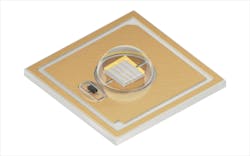While we have observed the slowing stream of ultraviolet (UV)-focused product announcements, advances are still coming — through both well-known and perhaps under-the-radar players in global LED markets. Ams Osram recently announced a new emitter in its germicidal UV portfolio, while Silanna UV has debuted two UV devices targeting a broader range of sensing and detection possibilities.
OSLON adds high-power option for UV
Austria-based ams Osram has launched the 265-nm OSLON UV 6060, which delivers 100 mW of radiometric power out of the single die emitter at 250 mA. The 265-nm wavelength has been demonstrated as highly effective for germicidal UV applications. The optical solutions developer first entered the UV-C LED market with its OSLON UV 3636 emitters back in late 2020 — a smaller-footprint device offering at 3.6×3.6 mm but also a lower-power one, with one version delivering 4.5 mW of radiometric power when driven at 30 mA and a mid-power version delivering 42 mW at 350 mA. The 6×6-mm aluminum gallium nitride (AlGaN)-based, ceramic-packaged flip chip is capable of withstanding operating temperatures up to 60°C. According to ams Osram, the form factor is still plenty compact enough for integration into a variety of appliances and equipment for multiple modes of disinfection.
"With the OSLON UV 6060 we are accelerating the industrialization of UV-C LEDs in the growing field of purification and sanitization of air, surfaces, and water,” Nina senior product manager Nina Reiser said. “The new OSLON UV-C LED is ideal for applications which require maximum germicidal effectiveness at high power levels while providing outstanding wall-plug efficiency. There are a variety of benefits compared to traditional lighting technologies such as adaptability, compactness, and instant-on functionality."
Ams Osram appears to already have begun leveraging a short-pulse testing method for evaluating the OSLON UV 6060, as the datasheet indicates peak wavelength was derived using a current pulse duration of 10 ms and a tolerance of ±3 nm. Metrology specialists recently explained that short-pulse measurements less than 20 ms are of particular benefit in minimizing heating-induced measurement errors and circumventing transient voltage effects that can be exhibited during UV LED testing.
Silanna debuts 235- and 255-nm LEDs
Brisbane, Australia-based Silanna UV recently announced the 235-nm SF1 and 255-nm SN3 series LEDs (covering what the company describes as far UV-C and deep UV-C wavelengths, respectively). Acquired from Peregrine Semiconductor nearly 15 years ago, Silanna UV leverages power-semiconductor manufacturer Silanna Group's nanostructured short-period super-lattice (SPSL) technology that alternates thickness of AlN and GaN layers to reduce losses and maintain high power at shorter wavelengths. LEDs Magazine hopes to bring readers more information on the properties of this layered material in upcoming content.
Silanna claims the improvements in electrical properties with SPSL enable lower power consumption, longer lifetimes, and reduced cost to implement both UV LED series in a variety of use cases, including water quality sensors, gas detection, medical analyzers, liquid chromatography, and sterilization.
The 235-nm SF1 and 255-nm SN3 series both offer 120° or 30° viewing-angle SMD packages. The company says the parabolic lens in the 30° package lens provides "greater irradiance" than mercury-vapor UV lamps but did not provide comparative data in its product announcement.
CARRIE MEADOWS is managing editor of LEDs Magazine, with 20 years’ experience in business-to-business publishing across technology markets including solid-state technology manufacturing, fiberoptic communications, machine vision, lasers and photonics, and LEDs and lighting.
For up-to-the-minute LED and SSL updates, follow us on Twitter. You’ll find curated content and commentary, as well as information on industry events, webcasts, and surveys on our LinkedIn page and our Facebook page.








